| Among the more common --if not the most common-- houseplant members of the Sunflower Family, is my featured genus this month: Gynura. Inconsistent names are used for these plants in horticultural books, websites and nursery catalogs. This article attempts to clarify the matter. Most credit is due to research published in 2008 and 2009 by Dr. Ongkarn Vanijajiva, of Phranakhon Rajabhat University, Thailand. |
Unlike most Sunflower Family plants used as houseplants, the Gynura genus is tropical. It consists of 44 species of perennials or subshrubs. They are native from Africa to S Asia east through S China, Japan, SE Asia and New Guinea into N Australia; growing in open places, such as forest gaps, or along riversides or roadsides. Below, reflecting their presence in western cultivation, I treat only 3 of the 44 species, and 1 hybrid.
|
| Velvet Plant. Purple Velvet Plant. Royal Velvet Plant. Velvet Tree. Purple Passion Tree |
Gynura aurantiaca (Bl.) A. DC.
|
Native to Sri Lanka, India, China and Indonesia; in open places in evergreen forests; an abundant weed.
|
A robust subshrub 3 to 6.5 feet (1-2 m) high or more, its stout stems erect, densely to sparsely ± purple-hairy. Leaves up to 7 inches long by 4 inches wide, egg-shaped or lyrate with 1-3 pairs of lobes. The leaves are thick and usually plush with velvety purple hairs. But if there is too much shade, or the atmosphere is too dry, or too hot, then they become less hairy. The brick-red to yellow flowers are malodorous and often cut off. It is grown, like its cousins, for pleasing foliage, not floral beauty.
|
Glasshouse Works reports: "best grown in a warm winter greenhouse/conservatory situation. Definitely not a houseplant nor an outstanding (predictable?) patio subject like the other species. Not for easily exasperated growers: upright stems may topple with time or sheer lack of backbone, so best to stake early on."
|
In past decades it was more common; now is rare, replaced by its hybrid 'Purple Passion' (below) --which however, may be sold incorrectly under the Gynura aurantiaca name. I have not grown this species.
|
| Purple Passion Vine or Plant. Purple Velvet-Plant |
| Gynura 'Purple Passion' |
| = Gynura aurantiaca 'Purple Passion' |
| = Gynura aurantiaca 'Sarmentosa' |
| = Gynura sarmentosa var. hirsuta hort. |
| = Gynura sarmentosa hort. non (Bl.) DC. |
= Gynura procumbens hort. non (Lour.) Merr.
|
This is the very common ornamental houseplant representative of the genus. The clone is of obscure origin, first widely cultivated in the mid- to late 1960s, its Purple Passion name coined by North American florists around 1971. Compared to G. aurantiaca, it is more purple-hairy, graceful and slender in stems and leaves, eventually flopping about like a vine. People enjoy touching its thick succulent leaves, darkest green on top, and shiny purple with hairs beneath. Its flowers are egg-yolk yellow.
|
A 1981 scholarly paper by Frances G. Davies reported of it: "The nearest morphological match among wild individuals is a Javanese G. procumbens in all respects similar but quite hairless." However, most people think a more likely origin is that it is a hybrid between G. aurantiaca and G. procumbens. Raising seedlings from it and observing them, or trying intentional crosses between its supposed parents, would prove the matter.
|
It is very easily grown indoors, unlike G. aurantiaca. It can tolerate more winter chill, and lower humidity. If keeping the plant compact rather than flopping all over is desired, simply pinch it back. Try to not get water on the leaves, as they can get ugly brown spots of rot when their thick hairs trap it. Do not let it fry in full sun, but give it bright indirect light. I have grown a specimen since 2010.
|
| Okinawa or Okinawan Spinach. Oakleaved Velvet-Plant |
| Gynura bicolor (Roxb. ex Willd.) A. DC. |
| = Gynura angulosa var. petiolata Hook. |
| = Gynura crepidioides hort. non Benth. |
= Cacalia bicolor Roxb. ex Willd.
|
Native to S China, Burma and Thailand; widely cultivated there and elsewhere. Grows 3 to 13 feet (1-4m) high, stems erect, fleshy to subsucculent, sparsely hairy. Leaves slender, up to 16 inches long by 6 inches wide (but usually half that size), usually dark green or rich purple beneath, densely to sparsely hairy, margins sharply toothed. Flowers dark red to orange-yellow, their stems hairy.
|
Little grown as an ornamental. This and the following species are grown as perennial vegetables, their young shoots and leaves eaten raw or cooked. It is easily propagated by cuttings. One source reports that raised from seeds it reverts to the original all green version and loses the beautiful purple underside of the leaves. This plant is commonly misidentified as Gynura crepidioides on websites, including wikipedia.
|
Specimens I obtained in 2009 and 2010 died. I think they were getting too little light, were stressed, and scale insects did them in. I obtained a new plant this month, and am giving it more light.
|
| Scrambling Gynura. Dawn or Daun Dewa. Leaves of the Gods. Moluccan Spinach. Cholesterol Spinach. Longevity Spinach |
| Gynura procumbens (Lour.) Merr. |
= Gynura sarmentosa (Bl.) DC.
|
Native from W Africa and Asia from India, China, Myanmar, Thailand, Malaysia, Philippines, Indonesia to Papua New Guinea. It grows 6.6 to 16.5 feet (2-5 m) high or more, climbing on trees in wooded ravines, with robust stems scrambling to climbing. Leaves elliptical to rhomboid, up to 4.5 inches long by 2.5 inches wide, lightly hairy or hairless. Purple on top with strikingly contrasting green veins; purplish underneath --unless in too much shade, whereupon wholly green. Very variable in the toothing of the leaf margin, the shape of the leaf base, etc. Flowers yellow or orange-red or purple, their stems practically hairless. Flowers are sparse on cultivated clones.
|
Even more grown than G. bicolor, with many ascribed medicinal properties. Like many plants, it contains pyrrolizidine alkaloids, generally detrimental to humans.
|
I obtained a plant from a friend, and it died; another that I had bought in June 2010, is still alive, and robust, but due to lack of enough light, it is lanky, and has lost all its purple leaf color, as is shown in my photo.
|
As for food, I eat raw or lightly cooked all of the Gynura listed above, except Gynura aurantiaca. That species has not been recorded as eaten, and I have never had a specimen to taste in any event. Gynura flavor is pleasingly mild, and recalls that of goldenrod leaves (Solidago canadensis), groundsel leaves (Senecio vulgaris) and some other members of the sunflower family. I have not yet studied whether the beneficial health improvement afforded by eating Gynura leaves is compromised by the pyrrolizidine alkaloids. Surely the alkaloid levels vary from clone to clone, and according to other factors. After studying this, I will update this article. Meanwhile, since many people in the world eat the plants, and I have yet to see conclusive evidence that the practice is unsafe, I shall continue moderate consumption. To be on the safe side, I eat the youngest shoots and leaves, and for the most part cook them.
|
Here are my pictures for you.
Back |
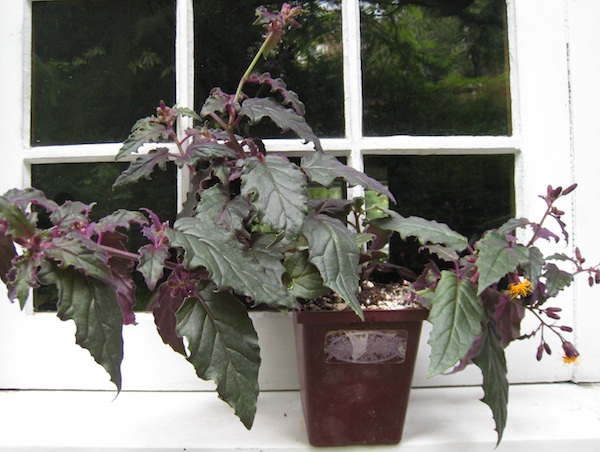
Gynura Purple Passion; photo by ALJ
|
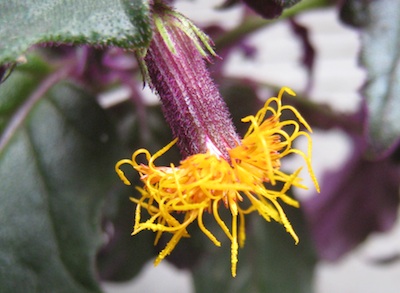
Gynura Purple Passion flower; photo by ALJ
|
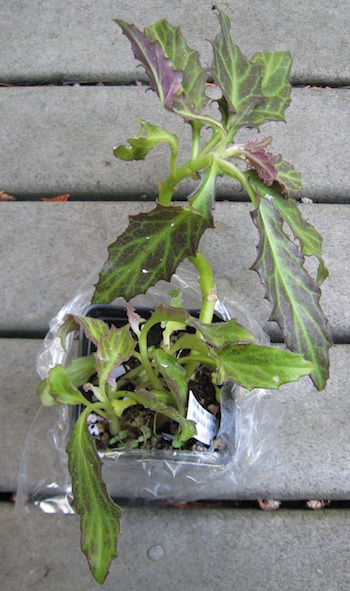
a young Gynura bicolor plant; photo by ALJ
|
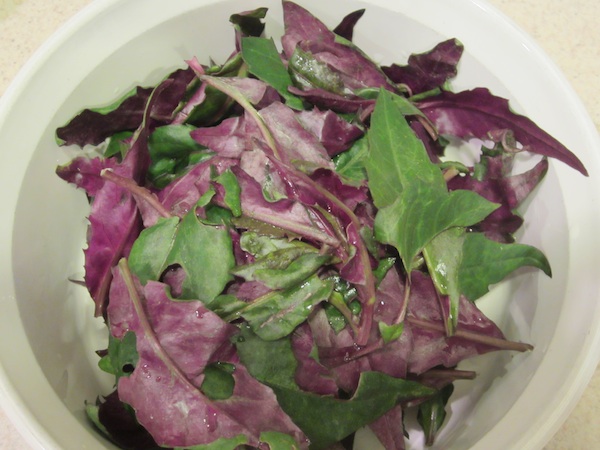
Gynura bicolor leaves ready to cook; photo by ALJ
|
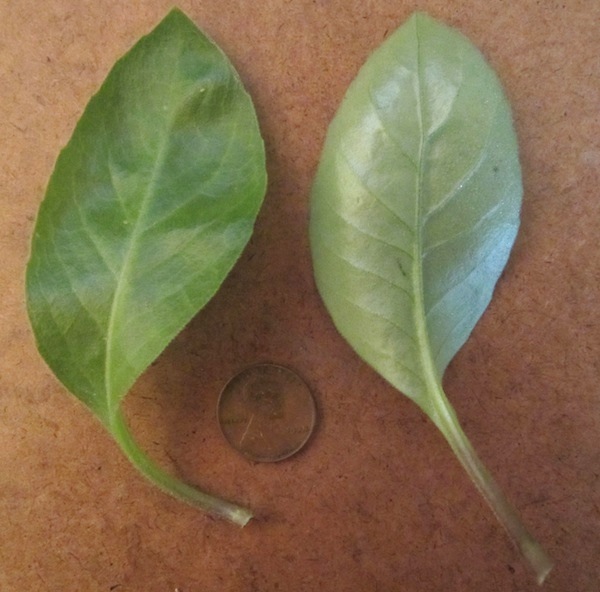
Gynura procumbens leaves; photo by ALJ
|

